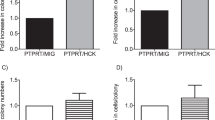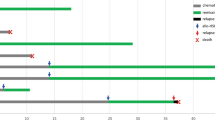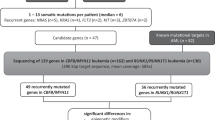Abstract
Chromosome translocations in the 5q31-33 region are associated with a range of hematologic malignancies, some of which involve the platelet-derived growth factor receptor beta (PDGFRB) gene. We report a case of acute myeloid leukemia (AML) with a mutation in the NPM1 gene (NPM1-mut AML) and a subclonal gene rearrangement involving the PDGFRB gene. We identified a novel fusion gene, STRN3::PDGFRB, resulting from t(5;14) (q32;q12) chromosomal rearrangement. Sequential FISH confirmed that ~15% of leukemic cells carried the PDGFRB gene rearrangement, which suggests that STRN3::PDGFRB is a previously unreported fusion gene in a subclone. Reverse transcription PCR (RT-PCR) and Sanger sequencing confirmed that the fusion gene consisted of STRN3 exon 7 fused to PDGFRB exon 11, resulting in a chimeric protein containing the coiled-coil domain of striatin-3 and the transmembrane and intracellular tyrosine kinase domains of the PDGFRB. The new protein exhibited distinct cytoplasmic localization and had leukemogenic effects, as demonstrated by its ability to transform Ba/F3 cells to growth factor independence and cause a fatal myelodysplastic/myeloproliferative neoplasm (MDS/MPN)-like disease in mice, which then transformant to T-cell lymphoblastic lymphoma in secondary recipients. Ba/F3 cells expressing STRN3::PDGFRB or ETV6::PDGFRB were sensitive to tyrosine kinase inhibitors (TKIs) and selinexor, but in vitro experiments showed that the combination of imatinib and selinexor had a marked synergistic effect, although only the imatinib alone group could prolong the survival of T-cell blast transformation recipient mice. Our findings demonstrate the leukemogenic effects of the novel fusion gene and provide insights into the clone evolution of AML, which can be influenced by therapy selection. Furthermore, our results provide insight into the potential therapeutic options for patients with this type of mutation, as well as the need for careful consideration of treatment selection to prevent undesirable side effects.

This is a preview of subscription content, access via your institution
Access options
Subscribe to this journal
Receive 12 print issues and online access
$259.00 per year
only $21.58 per issue
Buy this article
- Purchase on Springer Link
- Instant access to full article PDF
Prices may be subject to local taxes which are calculated during checkout







Similar content being viewed by others
Data availability
The main data supporting the results of this study are available within the article and supplementary materials.
References
Mitelman F, Johansson B, Mertens F. Mitelman Database of Chromosome Aberrations and Gene Fusions in Cancer. http://cgap.nci.nih.gov/Chromosomes/Mitelman. 2022.
Khoury JD, Solary E, Abla O, Akkari Y, Alaggio R, Apperley JF, et al. The 5th edition of the World Health Organization classification of haematolymphoid tumours: myeloid and histiocytic/dendritic neoplasms. Leukemia. 2022;36:1703–19.
Arber DA, Orazi A, Hasserjian RP, Borowitz MJ, Calvo KR, Kvasnicka H-M, et al. International consensus classification of myeloid neoplasms and acute leukemias: integrating morphologic, clinical, and genomic data. Blood. 2022;140:1200–28.
Roberts KG, Morin RD, Zhang J, Hirst M, Zhao Y, Su X, et al. Genetic alterations activating kinase and cytokine receptor signaling in high-risk acute lymphoblastic leukemia. Cancer Cell. 2012;22:153–66.
Roberts KG, Li Y, Payne-Turner D, Harvey RC, Yang YL, Pei D, et al. Targetable kinase-activating lesions in Ph-like acute lymphoblastic leukemia. N. Engl J Med. 2014;371:1005–15.
Tang Y, Fang G, Guo F, Zhang H, Chen X, An L, et al. Selective inhibition of STRN3-containing PP2A phosphatase restores hippo tumor-suppressor activity in gastric cancer. Cancer Cell. 2020;38:115–128.e9.
Miles LA, Bowman RL, Merlinsky TR, Csete IS, Ooi AT, Durruthy-Durruthy R, et al. Single-cell mutation analysis of clonal evolution in myeloid malignancies. Nature. 2020;587:477–82.
Bezerra MF, Lima AS, Piqué-Borràs M-R, Silveira DR, Coelho-Silva JL, Pereira-Martins DA, et al. Co-occurrence of DNMT3A, NPM1, FLT3 mutations identifies a subset of acute myeloid leukemia with adverse prognosis. Blood. 2020;135:870–5.
Verhaak RGW, Goudswaard CS, van Putten W, Bijl MA, Sanders MA, Hugens W, et al. Mutations in nucleophosmin (NPM1) in acute myeloid leukemia (AML): association with other gene abnormalities and previously established gene expression signatures and their favorable prognostic significance. Blood. 2005;106:3747–54.
Falini B, Mecucci C, Tiacci E, Alcalay M, Rosati R, Pasqualucci L, et al. Cytoplasmic nucleophosmin in acute myelogenous leukemia with a normal karyotype. N. Engl J Med. 2005;352:254–66.
Svaldi M, Lanthaler A, Venturi R, Coser P, Mitterer M. Simultaneous occurrence of bcr-abl and inv16 in a case of M1 acute myeloid leukemia. Leukemia. 2001;15:695.
Bacher U, Haferlach T, Alpermann T, Zenger M, Hochhaus A, Beelen DW, et al. Subclones with the t(9;22)/BCR-ABL1 rearrangement occur in AML and seem to cooperate with distinct genetic alterations. Br J Haematol. 2011;152:713–20.
Suzuki T, Kiyoi H, Ozeki K, Tomita A, Yamaji S, Suzuki R, et al. Clinical characteristics and prognostic implications of NPM1 mutations in acute myeloid leukemia. Blood. 2005;106:2854–61.
McGowan-Jordan J, Simons A, Schmid M (eds.). ISCN 2016: An International System for Human Cytogenomic Nomenclature (2016). S. Karger AG, Switzerland, 2016.
Li H, Durbin R. Fast and accurate short read alignment with Burrows-Wheeler transform. Bioinformatics. 2009;25:1754–60.
Cibulskis K, Lawrence MS, Carter SL, Sivachenko A, Jaffe D, Sougnez C, et al. Sensitive detection of somatic point mutations in impure and heterogeneous cancer samples. Nat Biotechnol. 2013;31:213–9.
Saunders CT, Wong WSW, Swamy S, Becq J, Murray LJ, Cheetham RK. Strelka: accurate somatic small-variant calling from sequenced tumor-normal sample pairs. Bioinformatics. 2012;28:1811–7.
Chen X, Schulz-Trieglaff O, Shaw R, Barnes B, Schlesinger F, Källberg M, et al. Manta: rapid detection of structural variants and indels for germline and cancer sequencing applications. Bioinformatics. 2016;32:1220–2.
Boeva V, Popova T, Bleakley K, Chiche P, Cappo J, Schleiermacher G, et al. Control-FREEC: a tool for assessing copy number and allelic content using next-generation sequencing data. Bioinformatics. 2012;28:423–5.
Gale RE, Green C, Allen C, Mead AJ, Burnett AK, Hills RK, et al. The impact of FLT3 internal tandem duplication mutant level, number, size, and interaction with NPM1 mutations in a large cohort of young adult patients with acute myeloid leukemia. Blood. 2008;111:2776–84.
Miller CA, White BS, Dees ND, Griffith M, Welch JS, Griffith OL, et al. SciClone: inferring clonal architecture and tracking the spatial and temporal patterns of tumor evolution. PLoS Comput Biol. 2014;10:e1003665.
Nelson MD, Fitch DHA. Overlap extension PCR: an efficient method for transgene construction. Methods Mol Biol. 2011;772:459–70.
Ivey A, Hills RK, Simpson MA, Jovanovic JV, Gilkes A, Grech A, et al. Assessment of minimal residual disease in standard-risk AML. N Engl J Med. 2016;374:422–33.
Ianevski A, Giri AK, Aittokallio T. SynergyFinder 2.0: visual analytics of multi-drug combination synergies. Nucleic Acids Res. 2020;48:W488–W493.
Tomasson MH, Sternberg DW, Williams IR, Carroll M, Cain D, Aster JC, et al. Fatal myeloproliferation, induced in mice by TEL/PDGFβR expression, depends on PDGFβR tyrosines 579/581. J Clin Invest. 2000;105:423–32.
He Y, Wertheim JA, Xu L, Miller JP, Karnell FG, Choi JK, et al. The coiled-coil domain Tyr177 of bcr are required to induce a murine chronic myelogenous leukemia-like disease by bcr/abl. Blood. 2002;99:12.
Tomasson MH, Williams IR, Hasserjian R, Udomsakdi C, McGrath SM, Schwaller J, et al. TEL/PDGFbetaR induces hematologic malignancies in mice that respond to a specific tyrosine kinase inhibitor. Blood. 1999;93:1707–14.
Grisolano JL, O’Neal J, Cain J, Tomasson MH. An activated receptor tyrosine kinase, TEL/PDGFβR, cooperates with AML1/ETO to induce acute myeloid leukemia in mice. Proc Natl Acad Sci USA. 2003;100:9506–11.
Swanton C. Intratumor heterogeneity: evolution through space and time. Cancer Res. 2012;72:4875–82.
Dun KA, Vanhaeften R, Batt TJ, Riley LA, Diano G, Williamson J. BCR-ABL1 gene rearrangement as a subclonal change in ETV6-RUNX1–positive B-cell acute lymphoblastic leukemia. Blood Adv. 2016;1:132–8.
Neuendorff NR, Hemmati P, Arnold R, Ihlow J, Dörken B, Müller-Tidow C, et al. BCR-ABL+ acute myeloid leukemia: are we always dealing with a high-risk disease? Blood Adv. 2018;2:1409–11.
Catalano G, Niscola P, Banella C, Diverio D, Trawinska MM, Fratoni S, et al. NPM1 mutated, BCR-ABL1 positive myeloid neoplasms: review of the kiterature. Mediterr J Hematol Infect Dis. 2020;12:e2020083.
Vitale C, Lu X, Abderrahman B, Takahashi K, Ravandi F, Jabbour E. t(9;22) as secondary alteration in core-binding factor de novo acute myeloid leukemia. Am J Hematol. 2015;90:E211–212.
Sethapati VR, Jabr R, Shune L, El Atrouni W, Gonzales PR, Cui W, et al. De novo acute myeloid leukemia with combined CBFB-MYH11 and BCR-ABL1 gene rearrangements: a case report and review of literature. Case Rep. Hematol. 2020;2020:8822670.
Neuendorff NR, Burmeister T, Dörken B, Westermann J. BCR-ABL-positive acute myeloid leukemia: a new entity? Analysis of clinical and molecular features. Ann Hematol. 2016;95:1211–21.
Neuendorff NR, Schwarz M, Hemmati P, Türkmen S, Bommer C, Burmeister T, et al. BCR-ABL1(+) acute myeloid leukemia: clonal selection of a BCR-ABL1(-) subclone as a cause of refractory disease with nilotinib treatment. Acta Haematol. 2015;133:237–41.
Andrae J, Gallini R, Betsholtz C. Role of platelet-derived growth factors in physiology and medicine. Genes Dev. 2008;22:1276–312.
Arefi M, Garcia JL, Penarrubia MJ, Queizan JA, Hermosin L, Lopez-Corral L, et al. Incidence and clinical characteristics of myeloproliferative neoplasms displaying a PDGFRB rearrangement. Eur J Haematol. 2012;89:37–41.
Pozdnyakova O, Orazi A, Kelemen K, King R, Reichard KK, Craig FE, et al. Myeloid/lymphoid neoplasms associated with eosinophilia and rearrangements of PDGFRA, PDGFRB, or FGFR1 or with PCM1-JAK2. Am J Clin Pathol. 2021;155:160–78.
Arber DA, Orazi A, Hasserjian R, Thiele J, Borowitz MJ, Le Beau MM, et al. The 2016 revision to the World Health Organization classification of myeloid neoplasms and acute leukemia. Blood. 2016;127:2391–405.
Pear WS, Miller JP, Xu L, Pui JC, Soffer B, Quackenbush RC, et al. Efficient and rapid induction of a chronic myelogenous leukemia-like myeloproliferative disease in mice receiving P210 bcr/abl-transduced bone marrow. Blood. 1998;92:3780–92.
Spangrude GJ, Brooks DM, Tumas DB. Long-term repopulation of irradiated mice with limiting numbers of purified hematopoietic stem cells: in vivo expansion of stem cell phenotype but not function. Blood. 1995;85:1006–16.
Metzgeroth G, Schwaab J, Gosenca D, Fabarius A, Haferlach C, Hochhaus A, et al. Long-term follow-up of treatment with imatinib in eosinophilia-associated myeloid/lymphoid neoplasms with PDGFR rearrangements in blast phase. Leukemia. 2013;27:2254–6.
Jawhar M, Naumann N, Schwaab J, Baurmann H, Casper J, Dang T-A, et al. Imatinib in myeloid/lymphoid neoplasms with eosinophilia and rearrangement of PDGFRB in chronic or blast phase. Ann Hematol. 2017;96:1463–70.
Walker CJ, Oaks JJ, Santhanam R, Neviani P, Harb JG, Ferenchak G, et al. Preclinical and clinical efficacy of XPO1/CRM1 inhibition by the karyopherin inhibitor KPT-330 in Ph+ leukemias. Blood. 2013;122:3034–44.
Acknowledgements
This work was supported by grant 82270190 from the National Natural Science Foundation of China (NSFC); grant 2019YFC0840605 from the National Key Research and Development Program of China.
Author information
Authors and Affiliations
Contributions
ZW: Conceptualization, resources, data curation, formal analysis, validation, investigation, and writing-original draft. TL: Data curation, formal analysis, validation, and investigation. WL: Data curation and formal analysis. LW: Validation and investigation. XG: Data curation, validation, and investigation. SQ: Data curation and formal analysis. YS: Resources and investigation. ZT: Data curation and formal analysis. MW: Resources, formal analysis, and investigation. JW: Resources and supervision. YM: Conceptualization, supervision, funding acquisition, writing—review, and editing. SW: Resources and supervision.
Corresponding authors
Ethics declarations
Competing interests
The authors declare no competing interests.
Additional information
Publisher’s note Springer Nature remains neutral with regard to jurisdictional claims in published maps and institutional affiliations.
Supplementary information
Rights and permissions
Springer Nature or its licensor (e.g. a society or other partner) holds exclusive rights to this article under a publishing agreement with the author(s) or other rightsholder(s); author self-archiving of the accepted manuscript version of this article is solely governed by the terms of such publishing agreement and applicable law.
About this article
Cite this article
Wang, Z., Liu, T., Liu, W. et al. A novel subclonal rearrangement of the STRN3::PDGFRB gene in de novo acute myeloid leukemia with NPM1 mutation and its leukemogenic effects. Cancer Gene Ther 30, 1471–1484 (2023). https://doi.org/10.1038/s41417-023-00651-w
Received:
Revised:
Accepted:
Published:
Issue Date:
DOI: https://doi.org/10.1038/s41417-023-00651-w



